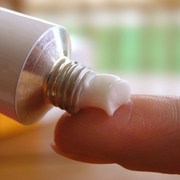 iStockphoto/Thinkstock
iStockphoto/Thinkstock
Corticosteroids are used for a variety of reasons, for instance, to ease painful skin conditions or suppress symptoms of allergy. As they are hormones, they can have side effects. The side effects depend on the type of steroid you use, and its concentration.
Steroid Creams
Topically applied creams are the least likely to cause side effects. The mildest type is hydrocortisone cream (0.5-2.5 percent) which is used for conditions like eczema, insect bites and allergic rashes.
Some very mild brands can be bought over the counter. The stronger concentrations have to be prescribed by a doctor.
The strongest type of steroid cream is clobetasol propionate (Temovate, Dermol or Dermovate depending on where you live) and this is 600 times stronger than hydrocortisone cream. Because of its very high potency, it is not recommended for use in infancy.
Side effects of topical steroids depend on where you put the cream. Different parts of the body absorb different amounts of steroid so the higher amount absorbed, the higher the likelihood of adverse reactions. For instance, if you put it on the palms of your hands, you will only absorb around 0.1 percent steroid, but if you put it on your genitals, you will absorb around 30 percent.
Side effects include:
• Easy bruising
• Skin thinning (usually only a problem if you use too much medication longer than four weeks)
• Stretch marks
• Increased likelihood of skin infections
• Allergy to the steroid cream
• If very strong steroid is used, e.g., clobetasol propionate, there is a risk of Cushing’s syndrome (weight gain, swelling of the legs, weak bones, high blood pressure, kidney stones, male infertility and erectile dysfunction, irregular periods or absent periods, diabetes and depression). This syndrome is caused by raised cortisol in the blood.
Inhaled Corticosteroids
Inhaled corticosteroids are used to treat conditions like asthma. Usually these have few or no side effects if you use as directed and on a temporary basis. If you use them long-term, you may get oral thrush (candida infection in your mouth).
Injected Corticosteroids
Corticosteroids can be injected into muscle or joints to help treat conditions such as osteoarthritis. However, these can cause a temporary increase in pain for a few days after the procedure, called a joint flare. Due to this, doctors sometimes inject a temporary anaesthetic block to the area to numb the pain.
If muscle and joint injections are done repeatedly, this can weaken the muscles. If corticosteroid hip injections are done to relieve hip arthritis, there is also evidence to suggest that they may increase post-operative infections after the patient has a total hip replacement.
Oral Corticosteroids
Steroids taken by tablet and used only for brief periods can cause:
• Acne
• Rapid mood swings and/or aggressive behavior
• Increased appetite and weight gain
Longer term use of oral steroids have similar side effects to very strong steroid cream, including Cushing’s Syndrome, high blood pressure, diabetes, bruising and thinning skin. It can also cause delayed wound healing and problems with the eyes, like cataracts or glaucoma.
People who are elderly may be at risk of bone fractures while they are taking corticosteroids so they may be prescribed calcium and vitamin D supplements at the same time.
One in 20 people may feel depressed or suicidal after taking oral corticosteroids or they may have hallucinations.
Oral corticosteroids lower immune system defences so the person is more vulnerable to infection. Normally uncomplicated childhood diseases such as measles or chickenpox may become serious to a person taking steroids, so they should avoid close contact with anyone who is ill.
Sources:
Topical Steroids, Derm Net NZ. Web. 30 March 2012. http://www.dermnetnz.org/treatments/topical-steroids.html
Corticosteroids, NHS Choices. Web. 30 March 2012. http://www.nhs.uk/Conditions/Corticosteroid-%28drugs%29/Pages/Sideeffects.aspx
Symptoms of Cushing’s Syndrome, NHS Choices. Web. 30 March 2012. http://www.nhs.uk/Conditions/Cushings-syndrome/Pages/Symptoms.aspx
Kaspar S, de V de Beer J (2005) Infection in hip arthroplasty after previous injection of steroid. J Bone Joint Surg Br 87-B:454–457
Joanna is a freelance health writer for The Mother magazine and Suite 101 with a column on infertility, http://infertility.suite101.com/
She is author of the book, "Breast Milk: A Natural Immunisation", and co-author of an educational resource on disabled parenting.
Reviewed March 30, 2012
by Michele Blacksberg RN
Edited by Jody Smith





Add a CommentComments
There are no comments yet. Be the first one and get the conversation started!